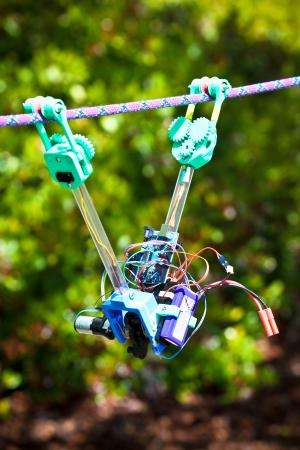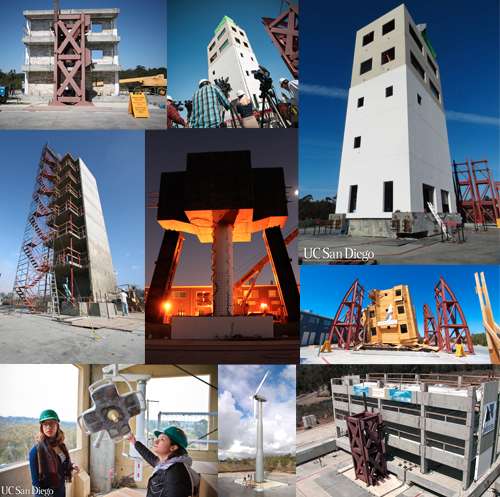SkySweeper is V-shaped with a motor-driven "elbow" and its ends are equipped with clamps that open and close as necessary to move it down utility lines, searching for damage, inch by inch. Credit: Jacobs School of Engineering/UC San Diego
The biggest outdoor shake table in the world and a robot designed to move along utility lines have received Best of What's New awards from Popular Science, the world's largest science and technology magazine. The two projects are featured in the magazine's December issue, now on newsstands.
The Large High Performance Outdoor Shake Table can handle structures weighing up to 2200 tons without height restrictions. The table's powerful hydraulic actuators—piston-like devices—can move at up to six feet per second, creating realistic simulations of the most devastating earthquakes ever recorded.
SkySweeper, designed in the Coordinated Robotics Lab at the University of California, San Diego, is a robot made of off-the-shelf electronics and plastic parts printed with an inexpensive 3D printer. The prototype could be scaled up for less than $1,000, making it significantly more affordable than the two industrial robots currently used to inspect power lines.
"The Best of What's New Awards is our magazine's top honor, and the 100 awardees are selected from a pool of thousands," said Cliff Ransom, executive editor of Popular Science. "Each winner is handpicked and revolutionary in its own way. Whether they're poised to change the world or simply your living room, the Best of What's New awardees challenge us to the see the future in a new light."
SkySweeper, a robot to inspect utility lines
SkySweeper is V-shaped with a motor-driven "elbow" in the middle. The ends of the robot's arms are equipped with clamps that open and close to move it down a line in an inchworm motion. The clamps can also release from the line one at a time and swing in a hand-over-hand motion. This will allow the robot to swing past cable support points.
The NEES @ UCSD shake table has been used to test a wide variety of structures. Clockwise from center of top row: a five-story building equipped with non-structural components (two pictures), a soft-story wood frame building, a precast concrete structure, a wind turbine, interior of the five-story building's surgery suite, a seven-story building, a three-story masonry building and a bridge column (image at the center). Credit: Jacobs School of Engineering/UC San Diego
"This project is a stellar example of how, leveraging modern technologies, clever mechanical designs and control algorithms can be used to achieve important and complex goals with simple and inexpensive robotic systems," said Thomas Bewley, a professor of mechanical engineering at the Jacobs School of Engineering at UC San Diego. In the future, SkySweeper could be outfitted with induction coils that would harvest energy from the power line itself, making it possible for the robot to stay deployed for weeks, or months, at a time. It could also be equipped with a camera, which would transmit images to an inspection crew. Other sensors could detect frayed cables, branches tangled in the line, and other issues.
Nick Morozovsky, a Ph.D. student in Bewley's lab, introduced the robot at the IEEE/RSJ International Conference on Intelligent Robots and Systems (IROS), from Nov. 3 to 8 in Tokyo. His paper was titled "SkySweeper: A Low Degree of Freedom, Dynamic High Wire Robot."
"The revolutions in low-cost microcontrollers and 3D printers have enabled rapid prototyping of complex robotic systems, such as SkySweeper, that can take novel dynamics and controls problems from simulation to reality," Morozovsky said.
The world's largest outdoor shake table
UC San Diego's shake table, housed at the Englekirk Structural Engineering Center in Scripps Ranch, has been used to test everything from wind turbines, to masonry, wood-frame and precast concrete buildings, as well as non-structural building elements, such as stairs, elevators and even hospital equipment. The table is part of the George E. Brown Network for Earthquake Engineering Simulation, or NEES, an initiative backed by the National Science Foundation.
"The NEES-UCSD shake table is a unique and very important tool for knowledge discovery in earthquake hazard mitigation, i.e. to better understand how to protect structures from earthquakes," said Joel Conte, a structural engineering professor at the Jacobs School of Engineering at UC San Diego, and one of the co-principal investigators for the shake table.
The 25 ft. by 40 ft. table is the largest in the United States. It has been used by researchers from around the nation. "The research findings will have a profound impact on the seismic resilience of the built environment worldwide," said José Restrepo, also a professor in the Department of Structural Engineering and co-PI.
Most recently, a team from Colorado State University tested seismic retrofits on a so-called soft-story wood-frame building, with an open first floor and three stories of apartments above. The open-plan first floor is particularly vulnerable during earthquakes. The tests were featured in a segment on NOVA's "Making Stuff Safer."
Last year, a team of researchers led by UC San Diego engineers put to the test a fully equipped five-story building, which included an intensive care unit, a surgery suite, piping and air conditioning, fire barriers and a working elevator. The goal of the $5 million project was to ascertain what needs to be done to make sure that high-value buildings, such as hospitals and data centers, remain operational after going through an earthquake. Researchers also assessed whether the building's fire barriers were affected by the shakes.
The table has often been in the media spotlight over the years for tests like these, with stories on PBS, NBC, CBS and ABC News, the Discovery Channel and The New York Times, among others.
Provided by University of California - San Diego

























